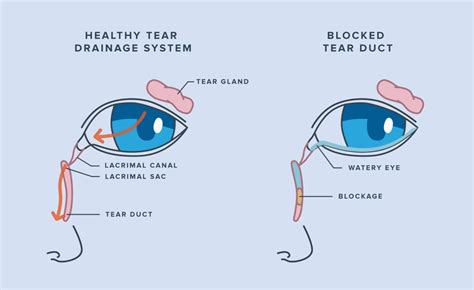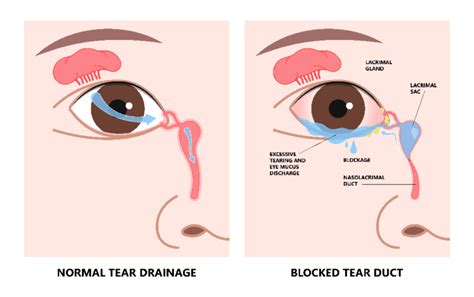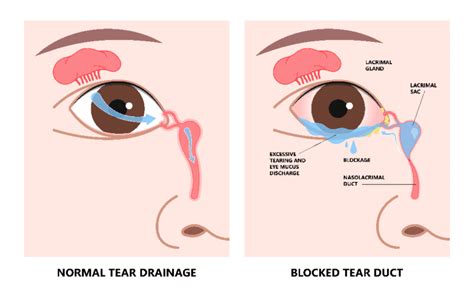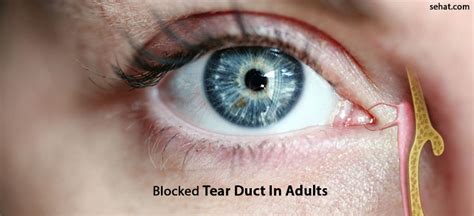Intro
Discover 5 ways to address tear duct blockage, including symptoms, causes, and treatments like surgery, probing, and massage, to relieve watery eyes and promote healthy tear flow and drainage.
The eyes are one of the most sensitive and delicate parts of the human body, and any issue affecting them can be quite distressing. One common problem that can cause discomfort and concern is a tear duct blockage. This condition occurs when the tear ducts, which are responsible for draining tears from the eyes into the nasal cavity, become blocked. As a result, tears cannot drain properly, leading to a range of symptoms including excessive tearing, eye irritation, and increased risk of eye infections. Understanding the causes, symptoms, and treatments of tear duct blockage is essential for managing the condition effectively.
Tear duct blockage can affect anyone, regardless of age, though it is more common in infants and the elderly. In babies, the condition often resolves on its own as the tear ducts develop, but in adults, it may require medical intervention. The blockage can be caused by various factors, including narrow tear ducts, injury to the face, infection, or tumors. Identifying the underlying cause is crucial for determining the best course of treatment. For instance, if the blockage is due to a narrow tear duct, a simple procedure might be sufficient, whereas an infection might require antibiotic treatment.
The symptoms of tear duct blockage can vary from mild to severe and include excessive tearing, redness and swelling of the eye, discharge or pus in the eye, and pain or tenderness around the eye. In some cases, the blockage can lead to recurrent eye infections, which can be quite painful and may affect vision if left untreated. It is essential to seek medical attention if symptoms persist or worsen over time. A healthcare provider can diagnose tear duct blockage through a physical examination and possibly imaging tests to determine the cause and extent of the blockage.
Understanding Tear Duct Blockage

Causes of Tear Duct Blockage
The causes of tear duct blockage can be congenital, meaning present at birth, or acquired, developing later in life. Congenital blockages are often due to underdeveloped tear ducts, while acquired blockages can result from various factors such as injury, infection, or age-related changes. In some cases, a blockage might be caused by a tumor or cyst that obstructs the tear duct. Understanding the cause is key to selecting the appropriate treatment.Symptoms of Tear Duct Blockage

Treatment Options for Tear Duct Blockage
Treatment for tear duct blockage depends on the underlying cause and the severity of the symptoms. For infants, a wait-and-see approach is often recommended, as many cases resolve on their own. For adults, treatment might involve antibiotics if there's an infection, or a minor surgical procedure to open up the blocked tear duct. In some cases, especially if the blockage is caused by a tumor or significant injury, more extensive surgery might be necessary.Diagnosing Tear Duct Blockage

Prevention of Tear Duct Blockage
Preventing tear duct blockage is not always possible, especially in cases of congenital conditions or unexpected injuries. However, good eye hygiene and prompt treatment of eye infections can reduce the risk of developing a blockage. Regular eye exams can also help in early detection and treatment of any issues related to the tear ducts.Treatments and Procedures for Tear Duct Blockage

Living with Tear Duct Blockage
Living with tear duct blockage requires managing symptoms and preventing complications. This can include using eye drops to moisten the eyes, avoiding irritants, and practicing good eye hygiene. It's also important to follow up with a healthcare provider to monitor the condition and adjust treatment as necessary.Complications of Untreated Tear Duct Blockage

Future Outlook for Tear Duct Blockage Treatment
The future outlook for tear duct blockage treatment is promising, with ongoing research into new and less invasive procedures. Advances in surgical techniques and technology are making treatments more effective and reducing recovery times. Additionally, there's a growing focus on preventive care and early intervention to reduce the risk of complications.Conclusion and Next Steps

If you or someone you know is experiencing symptoms of tear duct blockage, it's essential to consult with a healthcare provider. They can provide a proper diagnosis and recommend the best course of treatment. Remember, early intervention is key to preventing complications and ensuring the best possible outcomes.
What are the common causes of tear duct blockage?
+Tear duct blockage can be caused by congenital conditions, injuries, infections, or age-related changes. It's also possible for blockages to occur due to tumors or cysts that obstruct the tear duct.
How is tear duct blockage diagnosed?
+Diagnosis typically involves a physical examination, a review of symptoms, and possibly imaging tests or a dye test to visualize the tear ducts and identify any blockages.
What are the treatment options for tear duct blockage?
+Treatment options range from conservative management with warm compresses and massage to probing and irrigation, and in some cases, surgery to create a new passage for tear drainage.
We invite you to share your experiences or ask questions about tear duct blockage in the comments below. Your input can help others understand this condition better and seek the appropriate care. Additionally, if you found this article informative, please consider sharing it with others who might benefit from this information.
